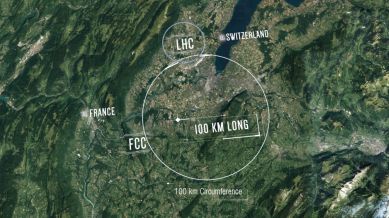CERN pushes plan for faster, bigger €20 billion particle accelerator
CERN is pushing its plan to build the Future Circular Collider, a particle accelerator that will dwarf the Large Hadron Collider.

CERN, the European Organization for Nuclear Research, is already home to the largest machine in the world — Large Hadron Collider (LHC). But now, it is pushing plans to build the three-times bigger (and faster) Future Circular Collider, which could cost as much as 20 billion euros.
The Large Hadron Collider is hosted inside a 27-kilometre long tunnel and the particle accelerator’s job is exactly what its name suggests: it accelerates protons and other subatomic particles to high speeds close to the speed of light and makes them collide with each other. It was instrumental in the discovery of the Higgs Boson — the so-called god particle —in 2012. Peter Higgs and other theoretical physicists were awarded the Nobel Prize in Chemistry the following year.
monthly limit of free stories.
with an Express account.
CERN executives expect to complete a feasibility study of the construction of the Future Circular Collider (FCC) next year, according to the Financial Times. FCC is a particle accelerator that will be within a 91-kilometre ring, which will give it three times the circumference of the Large Hadron Collider, according to Financial Times.
CERN has 23 member states that pay into the budget in proportion to their GDP, with Germany, the United Kingdom, France, and Italy being the biggest contributors. Just like with building other large particle accelerator projects before it, cost-optimisation and project management are expected to pose a much bigger challenge than anything technical. The FCC project has not yet been approved by the member states and the feasibility study will be one step towards that goal — it will work out many of the technical details and provide a “more serious” cost estimate.
“The feasibility study is due to be handed in at the end of 2025. Then we would hope to move towards approval,” said Mike Lamont, Director for Accelerators and Technology at CERN to indianexpress.com in a 2022 interview about FCC and CERN’s plans post-Large Hadron Collider. Even if everything were to go according to plan, the FCC would only be operational by “2045 by the very earliest,” according to Lamont.
Is the Future Circular Collider the same as the Large Hadron Collider?
“The LHC is a proton-proton machine. The European physics community has decided that the next machine it wants to do is an electron-positron collider to do a detailed study of the Higgs-Boson particle, what we call the Higgs factory,” said Lamont. “But the FCC is conceived as a two-stage machine. We start with electron-positron. Then, after ten odd years of operation, we move to proton-proton.”
Lamont describes a process that is similar to what happened with LHC. It started as an electron-positron. It was then converted into a proton-proton collider.
How do particle accelerators help us?
The €20 billion is not a small amount of money, and it is quite hard to justify spending so much on a theoretical physics project when the world is faced with many more pressing scientific challenges like those posed by climate change. But that is only if you make the assumption that FCC will yield nothing but particle physics knowledge.
CERN has an excellent track record of developing technologies that can be applied to fields beyond high-energy physics. In fact, the only reason you can read this article right now is because of CERN — British scientist Tim Berners-Lee invented the World Wide Web while working at the organisation. Many of the basic tools used by the organisation, like particle accelerators and detectors, also find applications in day-to-day life.
From innovations in superconductor technology to aerospace tech to cutting-edge medical applications like proton therapy, the operation of the Large Hadron Collider has also yielded knowledge that has helped make leaps and bounds in fields outside of particle physics. If the Future Circular Collider becomes a reality, there is no reason to believe it won’t do the same.